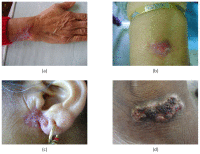Sporotrichosis in sub-himalayan India
- PMID: 22720100
- PMCID: PMC3373616
- DOI: 10.1371/journal.pntd.0001673
Sporotrichosis in sub-himalayan India
Abstract
Sporotrichosis is endemic in the Sub-Himalayan belt, which ranges from the northern to the north-eastern Indian subcontinent. Similar to many parts of the developing world, sporotrichosis is commonly recognized clinically in this region however consolidated epidemiological data is lacking. We report epidemiological, clinical and microbiological data from a hundred culture positive cases of sporotrichosis. Out of 305 clinically suspicious cases of sporotrichosis, a total of 100 isolates were identified as Sporothrix schenckii species complex (S. schenckii) on culture. Out of the culture proven cases 71% of the cases presented with lymphocutaneous type of lesions while 28% had fixed localized type and 1% had disseminated sporotrichosis. Presentation with lesions on hands was most frequently seen in 32% with arm (23%) and face (21%) in that sequence. The male to female ratio was 1∶1.27. Age ranged from 1 ½ years to 88 years. Mean age was 43.25 years. Disease was predominantly seen in the fourth to sixth decade of life with 58% cases between 31 and 60 years of age. Since the first report from the region there has been a steady rise in the number of cases of sporotrichosis. Seasonal trends reveal that most of the patients visited for consultation in the beginning of the year between March and April. This is the first study, from the most endemic region of the Sub-Himalayan belt, to delve into epidemiological and clinical details of such a large number of culture proven cases over a period of more than eighteen years which would help in the understanding of the local disease pattern of sporotrichosis.
Conflict of interest statement
The authors have declared that no competing interests exist.
Figures



Similar articles
-
Isolation of Sporothrix schenckii from the environmental sources of cutaneous sporotrichosis patients in Himachal Pradesh, India: results of a pilot study.Mycoses. 2007 Nov;50(6):496-501. doi: 10.1111/j.1439-0507.2007.01411.x. Mycoses. 2007. PMID: 17944713
-
Sporotrichosis in Mexico.Braz J Microbiol. 2021 Mar;52(1):49-62. doi: 10.1007/s42770-020-00387-x. Epub 2020 Oct 30. Braz J Microbiol. 2021. PMID: 33125684 Free PMC article.
-
Sporotrichosis in north-east India.Mycoses. 2007 May;50(3):201-4. doi: 10.1111/j.1439-0507.2006.01344.x. Mycoses. 2007. PMID: 17472617
-
Molecular identification and phenotypic characterisation of Sporothrix globosa from clinical cases of Eastern Assam, North-east India.Indian J Med Microbiol. 2017 Apr-Jun;35(2):269-273. doi: 10.4103/ijmm.IJMM_16_264. Indian J Med Microbiol. 2017. PMID: 28681818
-
Molecular identification of the Sporothrix schenckii complex.Rev Iberoam Micol. 2014 Jan-Mar;31(1):2-6. doi: 10.1016/j.riam.2013.09.008. Epub 2013 Nov 19. Rev Iberoam Micol. 2014. PMID: 24270070 Review.
Cited by
-
Phylogeography and evolutionary patterns in Sporothrix spanning more than 14 000 human and animal case reports.Persoonia. 2015 Dec;35:1-20. doi: 10.3767/003158515X687416. Epub 2015 Jan 29. Persoonia. 2015. PMID: 26823625 Free PMC article.
-
Sporotrichosis: The Story of an Endemic Region in Peru over 28 Years (1985 to 2012).PLoS One. 2015 Jun 1;10(6):e0127924. doi: 10.1371/journal.pone.0127924. eCollection 2015. PLoS One. 2015. PMID: 26030742 Free PMC article. Review.
-
A Spatial Analysis of the Spread of Hyperendemic Sporotrichosis in the State of Rio de Janeiro, Brazil.J Fungi (Basel). 2022 Apr 23;8(5):434. doi: 10.3390/jof8050434. J Fungi (Basel). 2022. PMID: 35628690 Free PMC article.
-
Comparative Genomic Data Provide New Insight on the Evolution of Pathogenicity in Sporothrix Species.Front Microbiol. 2020 Sep 30;11:565439. doi: 10.3389/fmicb.2020.565439. eCollection 2020. Front Microbiol. 2020. PMID: 33117312 Free PMC article.
-
Epidemiological and Clinical Aspects of Sporotrichosis in Espírito Santo State, Southeast Brazil: A Study of Three Decades (1982-2012).Am J Trop Med Hyg. 2019 Mar;100(3):706-713. doi: 10.4269/ajtmh.18-0667. Am J Trop Med Hyg. 2019. PMID: 30594269 Free PMC article.
References
-
- Chakrabarti A, Roy SK, Dhar S, Kumar B. Sporotrichosis in north-west India. Indian J Med Res. 1994;100:62– 65. - PubMed
-
- Kwon-Chung KJ, Bennett JE. Kwon-Chung KJ, Bennett JE, editors. Sporotrichosis. 1992. pp. 707– 729. Medical Mycology. Philadelphia: Lea & Febiger.
-
- De Araujo T, Marques AC, Kerdel F. Sporotrichosis. Int J Dermatol. 2001;40:737– 742. - PubMed
-
- Morris-Jones R. Sporotrichosis. Clin Exp Dermatol. 2002;27:427– 431. - PubMed
-
- Ghosh A, Chakrabarti A, Sharma VK, Singh K, Singh A. Sporotrichosis in Himachal Pradesh (north India). Trans R Soc Trop Med Hyg. 1999;93:41– 45. - PubMed
MeSH terms
LinkOut - more resources
Full Text Sources
Other Literature Sources
Miscellaneous

